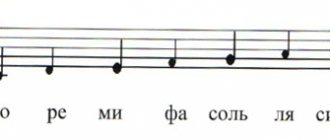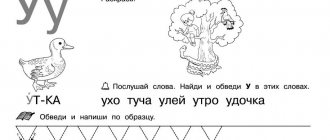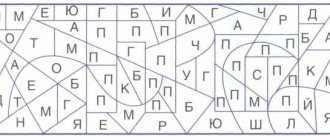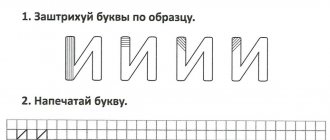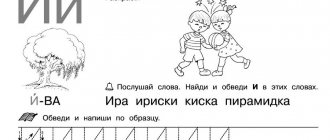E, e is the sixth letter of the Russian alphabet. It received its modern style at the beginning of the 18th century, under Peter I, after the introduction of the civil alphabet. Previously, it had the style of the Old Church Slavonic Cyrillic letter є (“there is”), which goes back to the letter of the Greek uncial e. In the Glagolitic alphabet it corresponds to the letter e. The digital value in the Cyrillic alphabet is 5, in the Glagolitic alphabet 6. The letter “E” means in writing: 1) the vowel “e” after soft consonants (“forest”) and hard hissing ones (“gesture”, “pole”); 2) the vowel “e” after “ts” (“target”) and after hard consonants in a number of borrowed words (“tent”, “muffler”); 3) the combination of “ye” at the beginning of a word (“fir”), after a vowel (“went”) and after a consonant (in this case, the so-called separating “ъ” and “ь” are written before “E” - “congress”, “ play"). After the spelling reform of 1917, “E” began to be written instead of “Ѣ” (see Yat), which at that time had the same literal meaning as “E” - “hay.” Since writing the letter “Ё” is not mandatory, “E” is often written instead: “len” (“linen”), “yellow” (“yellow”), “yolka” (“fir-tree”), “loan ” (“loan”), “volume” (“volume”), “drinks” (“drinks”).
History of origin
It is not known for certain when the letter E appeared in the history of languages. Presumably, the letter E arose when Cyrillic writing appeared. It is present in the Russian language and in all other Cyrillic alphabets, and began its journey in Greece.
The letter E in that alphabet was called “epsilon” and was the fifth letter of the alphabet, bearing a similar number in semantics - five. The exact origin of the letter is Phenicia.
Presumably, the Phoenician letter E, whose origins go back to Semitic writing, originally bore the sound “ha”.
We know when this letter appeared in the Russian language: with the emergence of the Cyrillic letter in Rus'. But it was actively used only with the introduction of the civil font. Before that, it was written as Greek epsilon – “ε”. Epsilon was written only at the beginning of a word in exceptional grammatical forms, and also sometimes after vowels. But it acquired its modern printed style with the first printing capabilities in the 17th century.
How to write texts correctly without errors?
To write texts competently, you need the ability to clearly express your thoughts and know the basic rules of writing. The help of a spelling textbook or an old school dictionary is indispensable here. You can write out complex words separately and analyze them.
A great exercise is rewriting texts. Even knowing all the rules of the Russian language, you need to be able to apply them in practice. You can write down the verse you have learned and check your spelling. It’s good to work in pairs and increase your literacy by working with dictations. Discussion of errors, healthy criticism and mutual control will help you better master correct spelling.
Even if you know all the rules of grammar, you need to be able to apply them in practice. It is enough to start with a sheet, gradually increasing the volume. Fine motor skills of the hands develop thought processes. To improve your spelling level, you need to make several days a week study days and devote 1-2 hours to your literacy.
It is also necessary to read regularly to improve your knowledge level. Classic works or modern stories shape the perception of words, their spelling and punctuation, and improve visual memory. Write down complex words with mistakes in the margins. After analyzing them, start studying the necessary rules. It is important to remember what you read. To write without errors, it is necessary to develop and train visual and auditory memory. If you regularly practice not only spelling, but also music and sports, accuracy in completing tasks is developed at a subconscious level.
Several important points of competent article writing
The initial stage of work comes down to familiarizing yourself with the topic from various sources.
Then a plan for the article is drawn up and a writing style is selected.
Avoid continuous text; in the form of a “sheet” it will be difficult to read. Small paragraphs are much easier for readers to understand. It is better to highlight important points in bold.
With a short and succinct title it is easier to attract attention.
After work, proofread the essay for errors and inconsistencies. It’s better to do this after a few hours to see all your shortcomings.
In addition to knowing the rules, you need to ensure silence while working and properly tune in to the topic of the article. If you work without breaks and days off, attentiveness gives way to overwork, and this affects the quality of the text.
Karamzin's influence on the letters E and E
The letter Yo in written form appeared much later than the emergence of Cyrillic writing, although it has been present in Russian speech since ancient times. Only at the beginning of the 18th century did Princess Vorontsova-Dashkova raise the question of creating a letter that would reflect the peculiarities of Russian pronunciation. They created a rule: the letter E was introduced into the alphabet.
In 1783, the letter “е” was recognized as official.
After the adoption of the provision on the written recording of Russian pronunciation, it was necessary to popularize the new letter and introduce it into its spelling. This was done by the linguist and critic Nikolai Karamzin, so many people attribute the creation of the letter “e” to him.
First of all, he published a collection of poems, in which he replaced the word “tears” with “tears”. As you can see, in contrast to modern trends in writing letters, “E” was not used in place of “ё” and had other features of pronunciation and writing.
Although there are studies by linguist V.T. Chumakov, who claim that the letter “e” was first used by the poet I. Dmitriev. However, this version has not become widespread among historians and linguists.
It was Karamzin who popularized the new letter: he simplified and shortened the spelling of words, thus making the prospect of studying the written language of the Russian language simpler and more understandable. As Karamzin planned, the letter “e” entered into common use.
Where does grammar come from?
Grammar is perhaps the most difficult part of any language. When we change the sequence of words, add additional verbs and suffixes, we are able to change the meaning of sentences. We are able to turn statements into questions, no matter the place or the action. We have various methods of constructing sentences to convey subtle changes in meaning.
Such things are not unique to Russian or English. Even if the language is called primitive, then you can find “smart” grammatical components in it. The Cherokee American Indian pronoun system is capable of distinguishing the meaning of sentences at the level of "you and I", "several people and I", "you, another person and I". In English, such sentences are reduced to the raw pronoun “we”. Grammar is universal. They play a vital role in every language, no matter where or how it is spoken. The question arises: “Who created grammar?”
Main question
This question seems impossible to answer. To find out how grammar was created, someone had to be present when the language was created and document its emergence. Historical linguists trace complex languages back to their ancestors. This provides some information, but we are able to obtain full-fledged facts only if the researcher observes the development of the language from its appearance. Surprisingly, it is possible.
Primitive languages
Some of the latest languages emerged due to the transatlantic slave trade. At that time, slaves from different ethnic groups were required to work together under the rules of the colonialists. Since they did not have the chance to learn each other's languages, they developed their own language called Pidgin. It includes modified constructions of the language spoken by land owners. Their grammar is presented in a simplified form. It is sometimes difficult for the listener to understand when an event occurred and who participated in it.
Children learning and developing Pidgin do not copy words. They use them to create new expressive designs.
Sign languages
People with disabilities also got the chance to learn their own sign languages. There is more than just a series of gestures here. The same grammatical structures are used here as in ordinary languages.
The creation of a similar language was recently recorded in Nicaragua. Previously, deaf people here were isolated from each other, but in 1979 the new government began building schools for the deaf. In the lessons they learned speech through lip reading, but in the play areas the children created their own sign system using gestures that they used in everyday life. Each child used signs with their own ideas, there was no consistent grammar.
When other children came to school, they developed a new system of signs that was different from the previous one. The younger children built on the signs of the older children, but their language was smoother and more compact. There, grammatical structures were used to clarify the meaning. A new language was born.
Conclusion
Some linguists believe that the constructions and words in some modern languages were introduced by creoles. Children are able to create grammatical rules due to neural plasticity. This leads to the emergence of first the simplest and then progressive languages.
Forgotten letter E
The letter “ё” in the Russian alphabet could not fully take root in writing, although it was intensively introduced into texts. This is justified by several reasons:
- The functionality of the letter “ё” has switched to the letter “E”, which is similar in spelling.
- With the development of computer writing, the letter “e” began to appear more and more in printed publications: it took less ink.
- Further, since on a computer keyboard it is located in a convenient position, unlike the letter “e”, therefore “e” began to be used more and more often.
- The bill regarding the letter “е” requires its writing in all printed publications and documents, although the law does not sufficiently regulate this area. This question is particularly relevant in modern linguistics. Because putting the wrong letter on a document can completely change a person's last name, rendering other documents invalid.
For example, the Russian surname “Seliverstov” originally sounded exactly like this (two roots, the plural word “verst”), but due to the incorrect use of letters, the surname “Seliverstov” (versat) appeared. As a result, the sound of the surname changed and a new etymological nest appeared.
What to do?
I will not be original in this case and, as in my other articles, I will say: try to resolve the issue peacefully first. Justify your position competently. Perhaps this will save you from the tedious dispute procedure. Moreover, a number of documents can simply be redone without resorting to any litigation. For example, if you find an erroneously indicated “ё” instead of “e” in your passport, you can simply replace your passport. Moreover, if the error occurred due to the fault of an official, then the replacement is carried out free of charge, regardless of the period when the error was discovered.
In some cases, a judicial perspective cannot be avoided.
You will need to go to a court of general jurisdiction. If there is no dispute about the law, the case will be considered according to the rules of special proceedings with features depending on which document the error was made.
Establishing facts of legal significance
Thus, courts resolve issues of establishing facts of legal significance. Such facts include, among other things, the fact that title documents (with the exception of military documents, passports and certificates issued by civil registry authorities) belong to a person whose name, patronymic or surname indicated in the document does not coincide with the name, patronymic or surname of this person indicated in the passport or birth certificate.
Proceedings in such cases are initiated by filing an application. However, a prerequisite is the impossibility of the applicant otherwise obtaining the appropriate documents certifying these facts, or if it is impossible to restore lost documents . Thus, due to non-compliance with this condition, the request of Kochkarev S.A. was refused. The Supreme Court of the Russian Federation indicated (Determination of the Supreme Court of the Russian Federation dated 02/09/2016 No. 20-KG15-23):
“From the case materials it is clear that the Ministry of Internal Affairs of the Republic of Dagestan, in order to make corrections to the certificate received by the applicant dated February 27, 1998 on rehabilitation (indicating the applicant’s patronymic) or issue a new certificate, Kochkarev S.A. didn't apply.
They did not provide any information about the impossibility of the applicant obtaining a certificate of rehabilitation in another (non-judicial) procedure.
Thus, the conditions necessary to establish the fact of Kochkarev’s ownership by S.A. There were no certificates of rehabilitation; this fact could not be established in accordance with Chapter 28 of the Civil Procedure Code of the Russian Federation.”
Thus, the trial in the manner provided for in Chapter. 28 of the Civil Procedure Code of the Russian Federation, it will be done if necessary to establish the identity of a person, for example, a certificate of inheritance, a work or pension book, an education document, a certificate of employment, etc.
Consideration of cases on making corrections or changes in civil registration records
If errors are made in the documents issued by the civil registry office, then for their correction you must contact the civil registry office directly by writing an appropriate application and submitting the required documents. The said application is considered by the civil registry office within one month. In exceptional cases, the period may be extended for another two months.
Based on the results of consideration of the application, the civil registry office draws up a conclusion on making a correction or change in the relevant entry. One of the grounds for such a conclusion is the presence of incomplete or incorrect information, as well as spelling errors. It seems that writing “e” instead of “e” is an example of such an error.
Refusal to make changes, indicating the reason, must be provided in writing and can be appealed to the court (Part 5, Article 72 of the Federal Law of November 15, 1997 No. 143-FZ “On Acts of Civil Status”).
The consideration of cases involving corrections or changes in civil status records is regulated by Ch. 36 Code of Civil Procedure of the Russian Federation. The basis for initiating proceedings in the case is a statement, which must indicate what the incorrect entry in the civil status act is, when and by what authority the correction or change of the entry made was refused. Of course, a refusal must be attached to the application.
Thus, the trial in the manner provided for in Chapter. 36 of the Civil Procedure Code of the Russian Federation, will be made if it is necessary to make changes to the birth certificate, marriage or divorce, establishment of paternity, change of name, etc.
The law also provides for a special procedure for considering applications for notarial acts performed or refusal to perform them (Chapter 37 of the Code of Civil Procedure of the Russian Federation).
How is the letter E written?
The capital letter E and the capital letter E have different spellings. The printed letter E is written like this: one vertical line and three horizontal ones, located at the top, bottom and center - this is how the capital letter E is written. The printed lowercase letter E was written in a similar way.
Although in modern typewritten text it has been transformed and has become similar to a capital letter, the upper horizontal line is rounded, forms an oval with the middle one, and the lower line also takes on the outline of a semicircle.
The capital letter E: the vertical line is rounded, the letter forms two semicircles, reminiscent of the number “3” turned to the right. The large letter E on a letter acquires individual author's features, so its spelling may vary.
The lowercase letter E is more difficult to write: the first and second lines form a circle or oval, slightly raised upward, the bottom line is rounded into a “tail.”
To create the letter E, dots are added to these spellings at the top.
This letter is one of the most difficult to write among primary schoolchildren.
Letter and sound
The letter E has two sounds: [je] (yot + e).
And “E” at the beginning of the 18th century replaced the combination of letters “io”, which had previously been used in its place. Thus, “ё” also makes two sounds: “jo” (jot + o).
Softness index
“E” and “E” are always an indicator of the softness of the preceding consonant. For example:
Place, mirror, pull ([m'e]sto, [z'e]rkalo, [d'o]tear – the letter “E” is an indicator of the softness of the consonant sound “d”, “m”, “z”).
As you can see, the letter E is an indicator of the softness of consonants, because it itself becomes the sound “e” and “o” (if it is the letter “e”), respectively.
There are exceptions in which these letters do not soften the preceding consonant. These exceptions are almost all borrowed words, for example:
- manager ([man]enger),
- annexation (an[ne]xia),
- aggression (ag[re]siya),
- thermal ([te]thermic),
- timbre ([te]mbre),
- express, (exp[re]ss).
Letter E after a vowel
The letters “E” and “E”, like other letters of the double alphabet (yu, ya), denoting two sounds, have a special relationship with other vowel sounds.
When the letter E is written after a vowel, it retains its two sounds [je]:
opening, train - pr[ayo]m, pr[aye]zd.
So the letter “o” sounds like “a”, and the letters “e” and “e” are replaced by [je] and [jo], respectively.
At the beginning of the word
At the beginning of a word, the letters “E” and “E” always mean two sounds, for example:
Hedgehog, ride - [yo]zh, [ye]ride.
In a similar way, these letters are written after hard and soft signs:
Drive away, rise - drive off [ye] drive up [yo]m.
Exceptions in which we do not write the letter “е” at the beginning of the word:
Yogurt, yoga - these two words are written strictly with the combination of letters “yo”.
Justified by the peculiarities of borrowing.
The essence of the problem
Imagine, one fine day you come to the registry office, to a notary or somewhere else and it turns out that you simply do not exist. Officially. Legally. You are dressed, moving, talking, but you cannot take a legally significant action. Because in your last name there is an “e” instead of “e” and it turns out that we are talking about a completely different person.
For example, the birth certificate contains the surname GrachEva, and when you reach the age of 14, you are given a passport in the name of GrachEva. All subsequent documents were issued using the passport, including the marriage certificate. You decide to take your husband's last name, which requires, among other things, a birth certificate. This is where everything comes up. After all, only citizen Gracheva legally exists - a person born was recorded under that name.
There can be many similar examples and much simpler ones. Let's say you, citizen Pugachev, come to draw up an inheritance, only the will was drawn up in the name of Mr. Pugachev - the notary will refuse you. Complications may also arise during the privatization of housing, divorce and other transactions.
According to statistics, about 3% of Russian citizens have the letter “ё” in their last names, first names and patronymics [2]. Accordingly, more than four million people may face problems similar to those described above. Unfortunately, we cannot exclude their occurrence. People draw up documents. Many of them, without any ulterior motive, can write “e” instead of “e”, since this is a common practice. The question is what to do if you find yourself in a similar situation.
Faced with this question, I wanted to know where all this confusion came from. I will summarize my studies briefly below, and for those who want to immediately move on to practical recommendations, read on.

